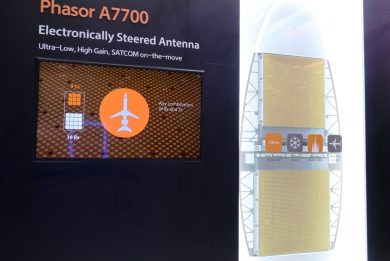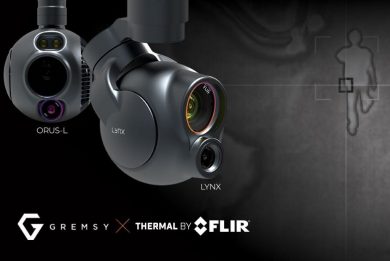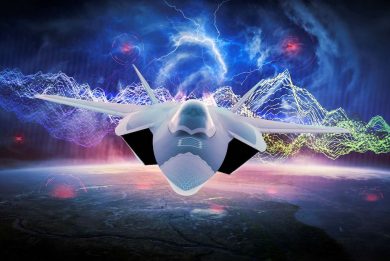
DSEI 2023 – Teledyne FLIR Black Recon: vehicle integrated reconnaissance capability
Leveraging the experience acquired with its Black Hornet VTOL micro-UAS, Teledyne FLIR developed a bigger system designed to be used from vehicles, the Black Recon, the airframe being only part of the game, as the key component of the system is the take-off and landing platform that allows it to be operated under armour by the crew
Originally designed by Prox Dynamics AS of Norway, the Black Hornet micro-UAS obtained considerable success as it could be carried by an infantry soldier adding minimal weight to his already heavy equipment, providing him a hand-launched and recovered short range reconnaissance capability. In 2016 the company was taken over by FLIR Systems of the USA, which was then acquired in 2021 by Teledyne, giving birth to what is today Teledyne FLIR. In fall 2018 FLIR Systems introduced the Black Hornet VRS (Vehicle Reconnaissance System) that included a launch unit holding multiple Black Hornet 3 UAVs, which could be mounted to the exterior of any military vehicle.

Tests and evaluations proved the Black Hornet VRS was too small to provide an effective reconnaissance tool for a vehicle, and this triggered the company R&D department to start thinking to a bigger solution, which was unveiled at DSEI 2023, the Black Recon.
The main research subject was not so much the air vehicle, a sort of Black Hornet on steroids, which maintains the helicopter-like architecture while weighing around 350 grams compared to less than 33 grams of the Black Hornet 3 Personal Reconnaissance System, but rather the launch and recovery system.
At DSEI the air vehicle was a mock-up of the UAV fuselage, with all sensors installed but with the main rotor replaced by a hook allowing a “full manual” approach to demonstrate the capture mechanism of the “box”, as the launch and recovery system is often referred to. One of the drivers of the new design was the box dimensions, the form factor being a key issue for allowing a smooth integration of the Black Recon system in as many vehicle types as possible. This resulted in a 680 x 650 x 450 mm object weighing less than 80 kg.

The system is based on a near-circular platform with two grabbing arms, which capture the air vehicle once it is in-bound grabbing the fuselage left and right. The platform is supported by three couples of articulated arms linked to servos allowing the platform full freedom of movement. Take-off is always relatively easy task, as what is mostly required is to keep the platform nearly horizontal; landing, especially when you have to put the air vehicle on a platform which diameter should be probably around 300 mm, is a wholly different story. The airframe software allows it to return to base while its optronic pick-up the landing platform and start the approach. EDR On-Line understood that at a certain distance the “box” comes into play, a camera located on one corner acquiring the incoming UAV. LED technology is used, with emitters in the non visible spectrum, installed on the airframe. Algorithms allow the system to accurately evaluate the location, the angle and the speed, bringing the UAV within “grabbing range”, the flying object and the box working fully automatically in a cooperative way, no operator assistance being required.
When the Black Recon lands another has already left the platform relieving in place the incoming one; this is then lowered in the “box”, rotated around 90° and inserted in one of the three available cassettes, where it will unload all the data gathered during the mission and reload the battery for the next mission, endurance being over 45 minutes. This will ensure a persistent surveillance for extended periods of time. All the relieve-in-lace process is conducted automatically, the system knowing the remaining battery charge and thus launching a replacement Black Recon in time to ensure seamless surveillance.
The Black Recon technology concept project is sponsored by the Norwegian Ministry of Defence. As previously said, at DSEI Teledyne FLIR focused on the launch and recovery system, the various system components being at different stage of development. The entire “box” is at TRL 7 and should be ready in December 2023 to start testing in early 2024 using a commercial UAV. The actual Black Hornet UAV is currently at TRL 6 but according to the company its development should be relatively quick as it will exploit components taken from other systems produced by the company, Teledyne FLIR aiming at aligning the readiness of the ground and air segments in summer 2024 in order to start qualification tests as soon as possible. EDR On-Line understood these will follow an increasing difficulty path, the aim being to launch and recover the air vehicle while the ground vehicle is on the move.

A few words on the airframe; as said it will have a typical main/tail rotor configuration, it will be powered by an electric motor that will allow a steady speed of 12 m/s (23 kts) and a wind dependent transit mode to waypoints up to 24 m/s (46 kts), the UAV being able to withstand wind gusts up to 14 m/s (27 kts) and moderate rain. A service ceiling of 3,600 metres (12,000 ft) will allow operations in high mountains, operating temperature range being -20°C/+49°C. The Black Recon is capable to operate in GPS denied areas, and can carry out emission control and radio denied operations. It is fitted with a collision avoidance system operating day and night, and its payload includes high resolution colour and thermal imaging sensors. Images can be relayed to the vehicle thanks to the data link, which range is of 5-6 km, however this can be eventually extended using one of the UAVs as radio relay.
Installed on a vehicle the Black Recon can ensure situational beyond line of sight, providing i.e. target location and positive identification of targets at maximum effective weapon range, and feed the ballistic computer with wind direction and speed data. Evaluating terrain conditions, identifying minefields or IEDs thanks to its thermal camera, as well as carrying out under-bridge inspection using onboard white illumination lights, are other possible applications. A single man is used to do so as all flying operations are carried out automatically, the Black Recon being capable to auto-generate path planning, using edge-processing for automatic detection.
While the system brochure defines it as a “technology concept” it is pretty sure that the system will soon become a product that will be added to the Teledyne FLIR portfolio.
Photos courtesy Teledye FLIR and P. Valpolini



